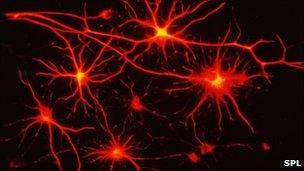Glasgow University researchers 'decode' brainwaves
- Published

The research team believes the findings could lead to brain-computer interfaces
Scientists believe they are a step closer to being able to read people's minds after decoding human brainwaves.
Glasgow University researchers asked volunteers to identify different emotions on images of human faces.
They then measured the volunteers' resulting brainwaves using a technique called electroencephalography (EEG).
Once researchers compared the answers to the brainwaves recorded, they were able to decode the type of information the brainwaves held relating to vision.
The research was carried out by the university's institute of neuroscience and psychology.
Six volunteers were presented with images of people's faces, displaying different emotions such as happiness, fear and surprise.
Facial information
On different experimental trials, parts of the images were randomly covered so that, for example, only the eyes or mouth were visible. The volunteers were then asked to identify the emotion being displayed.
The participants' brainwaves were measured using EEG which allowed the researchers to identify which parts of the brain were active when looking at different parts of the face.
Brainwaves vary widely in frequency, amplitude and phase.
In this study, the researchers found that 'beta' waves which have a cycle of 12 Hertz (Hz) carried information about the eyes, while 'theta' waves at 4Hz encoded information about the mouth.
The researchers also found information could be encoded depending on the phase - or timing of the brainwave - and less so by its amplitude - or strength.
Institute director, Professor Philippe Schyns, who led the study, said: "It's a bit like unlocking a scrambled television channel. Before, we could detect the signal but couldn't watch the content - now we can.
"While we are able to detect EEG activity in certain areas of the brain when particular tasks are performed, we've not known what information is being carried in those brainwaves.
Brain code
"What we have done is to find a way of decoding brainwaves to identify the messages within."
Prof Schyns said the research could give rise to other developments.
"By using multiple frequencies to encode two different parts of the face - a process called multiplexing - the brain can code more signals at the same time," he said.
"It is a bit like radiowaves coding different radio stations at different frequency bands. Likewise, the brain tunes in different waves to code different visual features.
"This work has huge potential in the development of brain-computer interfaces."